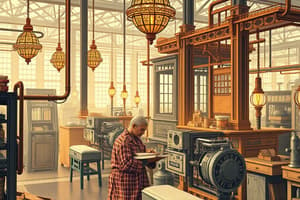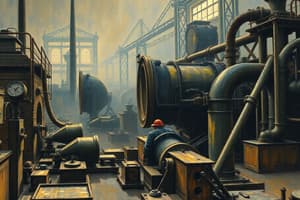Podcast
Questions and Answers
What is the primary goal of manufacturing processes?
What is the primary goal of manufacturing processes?
- To assemble a product
- To market a product
- To transform a blank or raw material into a finished product (correct)
- To design a product
Casting is a type of machining process.
Casting is a type of machining process.
False (B)
What type of manufacturing process involves changing the properties of a material?
What type of manufacturing process involves changing the properties of a material?
Property changing processes
The process of _______________ involves removing material from a workpiece to create a desired shape.
The process of _______________ involves removing material from a workpiece to create a desired shape.
Match the following manufacturing processes with their classification:
Match the following manufacturing processes with their classification:
What is the primary purpose of a gating system in sand casting?
What is the primary purpose of a gating system in sand casting?
A riser is a passage for bringing molten metal to the mould cavity.
A riser is a passage for bringing molten metal to the mould cavity.
What is the purpose of removing excess material from the casting after it is removed from the mould?
What is the purpose of removing excess material from the casting after it is removed from the mould?
The top part of the moulding box or flask is called the ____________________.
The top part of the moulding box or flask is called the ____________________.
Match the following terms with their definitions in sand casting:
Match the following terms with their definitions in sand casting:
What is the primary step in the casting process?
What is the primary step in the casting process?
The mold material should be able to withstand high temperatures.
The mold material should be able to withstand high temperatures.
What is the purpose of cores made of sand in casting?
What is the purpose of cores made of sand in casting?
A pattern is a replica of the ______________________ and is used for preparing the mold cavity.
A pattern is a replica of the ______________________ and is used for preparing the mold cavity.
What is the function of the gating system in casting?
What is the function of the gating system in casting?
The properties of the casting do not depend on the solidification time and cooling rate.
The properties of the casting do not depend on the solidification time and cooling rate.
What is the purpose of furnaces in casting?
What is the purpose of furnaces in casting?
Match the following steps in the casting process:
Match the following steps in the casting process:
Flashcards are hidden until you start studying
Study Notes
Manufacturing Processes
- Production involves transforming a blank or raw material into a finished product by changing its shape, size, and properties through a series of steps called production or manufacturing processes.
Classification of Manufacturing Processes
- Manufacturing processes can be classified into five categories:
- Shaping processes
- Machining processes
- Joining processes
- Finishing processes
- Property changing processes
Examples of Manufacturing Processes
- Shaping processes:
- Casting
- Forming
- Machining processes:
- Turning
- Drilling
- Milling
- Joining processes:
- Welding
- Brazing
- Soldering
- Finishing processes:
- Grinding
- Polishing
- Property changing processes:
- Annealing
- Hardening
Casting Process
- Casting is a process of producing metallic parts of desired shape and size by pouring molten metal into a mould cavity, allowing it to solidify, and resulting in a solid casting.
Moulding
- Moulding is a process of making a mould using a pattern, which is a model or replica of the part to be cast.
- Common materials for pattern making include wood, metals like cast iron, brass, and Al alloys.
Overview of Casting Process
- The casting process involves several steps: pattern making and mould making, melting and pouring, solidification and cooling, removal, cleaning, finishing, and inspection.
Pattern and Mould
- A pattern is a replica of the final product, used for preparing the mould cavity, and can be made of wood or metal.
- The mould cavity, which contains molten metal, is essentially a negative of the final product.
- Mould material should possess refractory characteristics and withstand the pouring temperature.
Melting and Pouring
- Several types of furnaces are available for melting metals, and furnace selection depends on the type of metal, maximum temperature required, and the rate and mode of molten metal delivery.
- The gating system should be designed to minimize turbulent flow and erosion of the mould cavity.
Solidification & Cooling
- The properties of the casting significantly depend on the solidification time and cooling rate.
- Shrinkage of casting during cooling should not be restrained by the mould material, otherwise, internal stresses may develop and form cracks in the casting.
Removal, Cleaning, Finishing and Inspection
- After the casting is removed from the mould, it is thoroughly cleaned, and the excess material is removed using a portable grinder.
Sand Casting
- Sand casting is a casting process in which sand moulds are used.
- Sand moulds are prepared in a moulding box or flask made of wood or metal, open at the top and bottom, and made in two parts held in alignment by pins.
- The gating system consists of a pouring basin, sprue, and gate.
- A riser is a passage to permit outflow of molten metal, acting as a reservoir of molten metal to compensate for solidification shrinkage.
- A core is a solid mass used to obtain a hole or recess in the final casting.
Studying That Suits You
Use AI to generate personalized quizzes and flashcards to suit your learning preferences.




